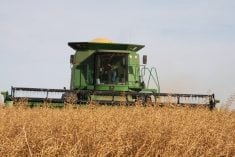During the last growing season I was involved in a number of trials for grain, corn and silage. We found accurate results that I could trust and share with other farmers in the area.
The corn trials inspired me to re-think our strategy with our trials regarding chemical products and the seed varieties we are selling on our farm and customers’ farms. I do not think we can get accurate data from half field trials, non-replicated trials or yield monitors.

We have performed many trials on our farm. Some of the issues that we have encountered are:
- Not planning out the trial on paper or digitally months ahead;
- Not adequately informing the operators running the drill or sprayer;
- Yield maps didn’t show the differences we expected, or it was difficult to see conclusive results;
- Not replicating the trials accurately;
- Not placing physical flags with labels on them in the field; and,
- Not allowing enough time at harvest to weigh through our weigh wagon.
In the future I would like to do cereal trials on our farm, just as they do corn trials. I hope to take the time to:
Read Also

Cancer agency reclassifies another herbicide ‘probably carcinogenic’
The WHO’s cancer research agency has now put atrazine, a herbicide well known to corn growers, in the same potential-hazard category where the agency put glyphosate.
- Plan the trial months ahead on paper or digitally;
- Keep the machine operators involved in the planning;
- Get product on farm ahead of season, and make sure rates are calculated;
- Mark the locations out with labeled flags at time of application;
- Replicate the plot;
- Weigh the production in the grain cart;
- Take samples for protein, moisture and grade from each plot;
- Measure the results (harvest will be slower that day); and,
- Remember that multiple seasons may be needed to get accurate data for some of these products.
If you’re doing trials on your farm this season, take the time to weigh the results. Harvest down the middle of the seeding or application area and on each side.

It is important to incorporate a few field trials into our season. It provides an opportunity to explain the results to ourselves, to our farm partners and to the public, and to make sure we know why we are using the products and genetics we are.
But, trials won’t tell you everything. Only once have I done a trial and found that yield monitor maps showed a clear winner.
















